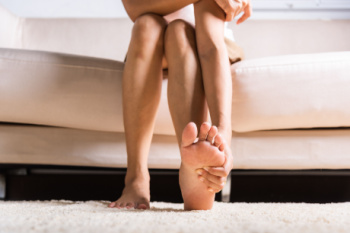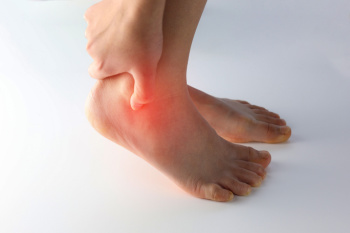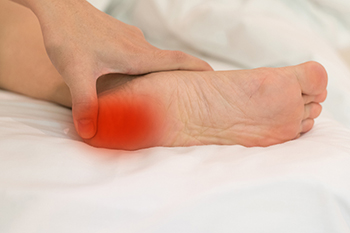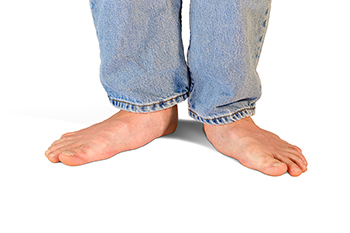Connect With Us
Blog
Items filtered by date: March 2024
Paying Attention to Common Foot Conditions

Our feet, often overlooked, play a vital role in our daily lives, bearing the weight of our bodies and facilitating movement. Several common foot conditions warrant attention and should not be ignored. Plantar fasciitis, characterized by heel pain caused by inflammation of the plantar fascia, can significantly impair mobility if left untreated. Bunions, bony bumps that develop at the base of the big toe, can cause discomfort and affect shoe fit. Additionally, ingrown toenails, which occur when the nail grows into the surrounding skin, can lead to infection and pain if not addressed promptly. Athlete's foot, a fungal infection that causes itching and peeling of the skin between the toes, can spread if untreated. Persistent foot pain, swelling, or changes in skin color should be evaluated by a podiatrist to rule out underlying conditions such as arthritis or nerve damage. If you have foot pain for any reason, it is strongly suggested that you consult a podiatrist as quickly as possible so the correct treatment can begin.
Foot Pain
Foot pain can be extremely painful and debilitating. If you have a foot pain, consult with one of our podiatrists from Family Foot Care of Long Island. Our doctors will assess your condition and provide you with quality foot and ankle treatment.
Causes
Foot pain is a very broad condition that could be caused by one or more ailments. The most common include:
- Bunions
- Hammertoes
- Plantar Fasciitis
- Bone Spurs
- Corns
- Tarsal Tunnel Syndrome
- Ingrown Toenails
- Arthritis (such as Gout, Rheumatoid, and Osteoarthritis)
- Flat Feet
- Injury (from stress fractures, broken toe, foot, ankle, Achilles tendon ruptures, and sprains)
- And more
Diagnosis
To figure out the cause of foot pain, podiatrists utilize several different methods. This can range from simple visual inspections and sensation tests to X-rays and MRI scans. Prior medical history, family medical history, and any recent physical traumatic events will all be taken into consideration for a proper diagnosis.
Treatment
Treatment depends upon the cause of the foot pain. Whether it is resting, staying off the foot, or having surgery; podiatrists have a number of treatment options available for foot pain.
If you have any questions, please feel free to contact our office located in Port Jefferson Station, NY . We offer the newest diagnostic and treatment technologies for all your foot care needs.
Understanding Tarsal Tunnel Syndrome

Tarsal tunnel syndrome, often likened to carpal tunnel syndrome in the wrist, is a condition that affects the feet and ankles. The tarsal tunnel is a narrow passageway on the inner side of the ankle, encased by bone and tissue, through which nerves and blood vessels pass. When this tunnel becomes compressed or squeezed, it can lead to tarsal tunnel syndrome. Symptoms can include a burning pain, tingling, or numbness in the inner ankle, heel, or sole of the foot. If left untreated, the condition can worsen, leading to weakness and muscle deterioration in the affected area. Several factors can contribute to tarsal tunnel syndrome, including injury, inflammation, or structural abnormalities in the foot. Diagnosing the condition involves a thorough examination by a podiatrist, often including imaging tests to rule out other potential causes. If you have pain as described above, it is suggested that you schedule an appointment with a podiatrist who can accurately diagnose and treat tarsal tunnel syndrome.
Tarsal tunnel syndrome can be very uncomfortable to live with. If you are experiencing tarsal tunnel syndrome, contact one of our podiatrists of Family Foot Care of Long Island. Our doctors can provide the care you need to keep you pain-free and on your feet.
Tarsal Tunnel Syndrome
Tarsal tunnel syndrome, which can also be called tibial nerve dysfunction, is an uncommon condition of misfiring peripheral nerves in the foot. The tibial nerve is the peripheral nerve in the leg responsible for sensation and movement of the foot and calf muscles. In tarsal tunnel syndrome, the tibial nerve is damaged, causing problems with movement and feeling in the foot of the affected leg.
Common Cause of Tarsal Tunnel Syndrome
- Involves pressure or an injury, direct pressure on the tibial nerve for an extended period of time, sometimes caused by other body structures close by or near the knee.
- Diseases that damage nerves, including diabetes, may cause tarsal tunnel syndrome.
- At times, tarsal tunnel syndrome can appear without an obvious cause in some cases.
The Effects of Tarsal Tunnel Syndrome
- Different sensations, an afflicted person may experience pain, tingling, burning or other unusual sensations in the foot of the affected leg.
- The foot muscles, toes and ankle become weaker, and curling your toes or flexing your foot can become difficult.
- If condition worsens, infections and ulcers may develop on the foot that is experiencing the syndrome.
A physical exam of the leg can help identify the presence of tarsal tunnel syndrome. Medical tests, such as a nerve biopsy, are also used to diagnose the condition. Patients may receive physical therapy and prescriptive medication. In extreme cases, some may require surgery.
If you have any questions please feel free to contact our office located in Port Jefferson Station, NY . We offer the newest diagnostic and treatment technologies for all your foot and ankle needs.
Wounds That Don't Heal Need to Be Checked
When to See a Doctor for Heel Pain
 Experiencing heel pain can significantly impact your daily life, making even simple tasks like walking or standing uncomfortable. Podiatrists, medical professionals specializing in foot and ankle health, can diagnose and treat heel pain. These types of doctors understand the complex structure of the foot and can identify the underlying causes of heel pain. Included are overuse injuries like plantar fasciitis, bone spurs, or Achilles tendonitis. Targeting the underlying cause of heel pain is important for appropriate care. It is especially important to seek the advice of a podiatrist if you have persistent pain, and if the pain comes suddenly or after an injury. A podiatrist can offer a personalized treatment plan that may include specialized exercises, custom orthotics, medication, or advanced therapies designed to alleviate pain and promote healing. Podiatrists can also provide valuable guidance on footwear choices and lifestyle modifications to prevent future pain. If you are suffering from heel pain, it is suggested you seek the help of a podiatrist for diagnosis and care.
Experiencing heel pain can significantly impact your daily life, making even simple tasks like walking or standing uncomfortable. Podiatrists, medical professionals specializing in foot and ankle health, can diagnose and treat heel pain. These types of doctors understand the complex structure of the foot and can identify the underlying causes of heel pain. Included are overuse injuries like plantar fasciitis, bone spurs, or Achilles tendonitis. Targeting the underlying cause of heel pain is important for appropriate care. It is especially important to seek the advice of a podiatrist if you have persistent pain, and if the pain comes suddenly or after an injury. A podiatrist can offer a personalized treatment plan that may include specialized exercises, custom orthotics, medication, or advanced therapies designed to alleviate pain and promote healing. Podiatrists can also provide valuable guidance on footwear choices and lifestyle modifications to prevent future pain. If you are suffering from heel pain, it is suggested you seek the help of a podiatrist for diagnosis and care.
Many people suffer from bouts of heel pain. For more information, contact one of our podiatrists of Family Foot Care of Long Island. Our doctors can provide the care you need to keep you pain-free and on your feet.
Causes of Heel Pain
Heel pain is often associated with plantar fasciitis. The plantar fascia is a band of tissues that extends along the bottom of the foot. A rip or tear in this ligament can cause inflammation of the tissue.
Achilles tendonitis is another cause of heel pain. Inflammation of the Achilles tendon will cause pain from fractures and muscle tearing. Lack of flexibility is also another symptom.
Heel spurs are another cause of pain. When the tissues of the plantar fascia undergo a great deal of stress, it can lead to ligament separation from the heel bone, causing heel spurs.
Why Might Heel Pain Occur?
- Wearing ill-fitting shoes
- Wearing non-supportive shoes
- Weight change
- Excessive running
Treatments
Heel pain should be treated as soon as possible for immediate results. Keeping your feet in a stress-free environment will help. If you suffer from Achilles tendonitis or plantar fasciitis, applying ice will reduce the swelling. Stretching before an exercise like running will help the muscles. Using all these tips will help make heel pain a condition of the past.
If you have any questions please contact our office located in Port Jefferson Station, NY . We offer the newest diagnostic and treatment technologies for all your foot and ankle needs.
Risks of Having Flat Feet

Flat feet, or fallen arches, pose several risks to foot health and overall well-being. This condition occurs when the arches of the feet collapse, causing the entire sole to come into contact with the ground. Flat feet can lead to a variety of issues, including foot pain, swelling, and fatigue, particularly after prolonged periods of standing or walking. Individuals with flat feet are more susceptible to overuse injuries, such as plantar fasciitis, Achilles tendonitis, and shin splints due to the altered biomechanics of the feet. Additionally, flat feet can contribute to misalignment of the ankles, knees, and hips, leading to discomfort and increasing the risk of developing osteoarthritis in these joints over time. Without proper support and management, flat feet can significantly impact mobility and quality of life. If you have flat feet, it is suggested that you are under the care of a podiatrist who can offer custom orthotics or other relief methods that are right for you.
Flatfoot is a condition many people suffer from. If you have flat feet, contact one of our podiatrists from Family Foot Care of Long Island. Our doctors will treat your foot and ankle needs.
What Are Flat Feet?
Flatfoot is a condition in which the arch of the foot is depressed and the sole of the foot is almost completely in contact with the ground. About 20-30% of the population generally has flat feet because their arches never formed during growth.
Conditions & Problems:
Having flat feet makes it difficult to run or walk because of the stress placed on the ankles.
Alignment – The general alignment of your legs can be disrupted, because the ankles move inward which can cause major discomfort.
Knees – If you have complications with your knees, flat feet can be a contributor to arthritis in that area.
Symptoms
- Pain around the heel or arch area
- Trouble standing on the tip toe
- Swelling around the inside of the ankle
- Flat look to one or both feet
- Having your shoes feel uneven when worn
Treatment
If you are experiencing pain and stress on the foot you may weaken the posterior tibial tendon, which runs around the inside of the ankle.
If you have any questions please feel free to contact our office located in Port Jefferson Station, NY . We offer the newest diagnostic and treatment technologies for all your foot and ankle needs.
Blog Archives
- March 2025
- February 2025
- January 2025
- December 2024
- November 2024
- October 2024
- September 2024
- August 2024
- July 2024
- June 2024
- May 2024
- April 2024
- March 2024
- February 2024
- January 2024
- December 2023
- November 2023
- October 2023
- September 2023
- August 2023
- July 2023
- June 2023
- May 2023
- April 2023
- March 2023
- February 2023
- January 2023
- December 2022
- November 2022
- October 2022
- September 2022
- August 2022
- July 2022
- June 2022
- May 2022
- April 2022
- March 2022
- February 2022
- January 2022
- December 2021
- November 2021
- October 2021
- September 2021
- August 2021
- July 2021
- June 2021
- May 2021
- April 2021
- March 2021
- February 2021
- January 2021
- December 2020
- November 2020
- October 2020
- September 2020
- August 2020
- July 2020
- June 2020
- May 2020
- April 2020
- March 2020
- February 2020
- January 2020
- December 2019
- November 2019
- October 2019
- September 2019
- August 2019
- July 2019
- June 2019
- May 2019
- April 2019
- March 2019
- February 2019
- January 2019
- December 2018
- November 2018
- October 2018
- September 2018
- August 2018
- July 2018
- June 2018
- May 2018
- April 2018
- March 2018
- February 2018
- January 2018
- December 2017
- November 2017
- October 2017
- September 2017

